
Citrus is a genus of flowering trees and shrubs in the rue family, Rutaceae. Plants in the genus produce citrus fruits, including important crops such as oranges, lemons, grapefruits, pomelos, and limes. The genus Citrus is native to South Asia, East Asia, Southeast Asia, Melanesia, and Australia. Various citrus species have been used and domesticated by indigenous cultures in these areas since ancient times. From there its cultivation spread into Micronesia and Polynesia by the Austronesian expansion ; and to the Middle East and the Mediterranean via the incense trade route, and onwards to Europe and the Americas.
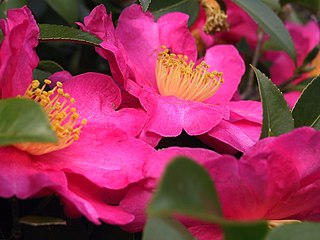
Camellia is a genus of flowering plants in the family Theaceae. They are found in eastern and southern Asia, from the Himalayas east to Japan and Indonesia. There are 100–300 described species, with some controversy over the exact number. There are also around 3,000 hybrids. The genus was named by Linnaeus after the Jesuit botanist Georg Joseph Kamel, who worked in the Philippines and described a species of camellia.

The mandarin orange, also known as the mandarin or mandarine, is a small citrus tree fruit. Treated as a distinct species of orange, it is usually eaten plain or in fruit salads. Tangerines are a group of orange-coloured citrus fruit consisting of hybrids of mandarin orange with some pomelo contribution.
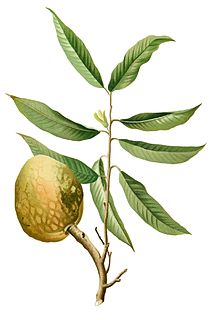
Annona reticulata is a small deciduous or semi-evergreen tree in the plant family Annonaceae and part of the Annonas group. It is best known for its fruit, called custard apple, a common name shared with fruits of several other species in the same genus: A. cherimola and A. squamosa. Its common names include wild sweetsop, soursop and bullock's heart. The fruit is sweet and useful in preparation of desserts, but is generally less popular for eating than that of A. cherimola.
Blythia reticulata, commonly known as Blyth's reticulate snake, Blyth's reticulated snake, or the iridescent snake, is a species of snake in the subfamily Natricinae of the family Colubridae of the superfamily Colubroidea. The species is endemic to Asia.

Camellia reticulata is a species of flowering plant in the tea family Theaceae, native to southwestern China, in Yunnan Province. The wild populations are restricted to mixed mountain forest in western and central Yunnan.

The blue-streaked lory is also known as the blue-necked lory. It is a medium-sized parrot (31 cm), which is found on the Tanimbar Islands and Babar in the southern Moluccas.

Plathymenia reticulata is a species of legume native to much of eastern South America. It is placed in its own genus, Platyhymenia, although other species have previously been recognised in that genus. It grows up to 30 m (98 ft) tall, and has distinctive flattened seed pods. Its wood is rot-resistant, and is widely used as a structural timber.

Carcharias is a genus of sand tiger sharks belonging to the family Odontaspididae. Once bearing many prehistoric species, all have gone extinct with the exception of the critically endangered sand tiger shark.

The streak-breasted honeyeater or streaky-breasted honeyeater is a species of bird in the family Meliphagidae. It is found on Timor island. Its natural habitats are subtropical or tropical moist lowland forest, subtropical or tropical mangrove forest, and subtropical or tropical moist montane forest.
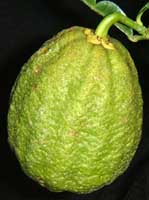
Papeda or papaeda is the common name for a group of citrus native to tropical Asia that are hardy and slow-growing, and produce unpalatable fruit. Walter Tennyson Swingle segregated these species into a separate subgenus, Papeda, that included the Ichang lemon, yuzu, kaffir lime, kabosu, sudachi, and a number of wild and uncultivated species and hybrids. Recent genetic analysis shows the papedas to be distributed among distinct branches of the citrus phylogenetic tree, and hence Swingle's proposed subgenus is polyphyletic and not a valid taxonomic grouping, but the term persists as a common name.

Syringa reticulata, the Japanese tree lilac. is a species of flowering plant in the family Oleaceae native to eastern Asia, which is grown as an ornamental in Europe and North America.
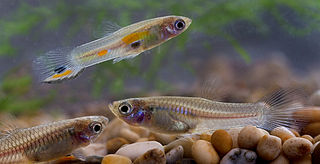
The guppy, also known as millionfish and rainbow fish, is one of the world's most widely distributed tropical fish and one of the most popular freshwater aquarium fish species. It is a member of the family Poeciliidae and, like almost all American members of the family, is live-bearing. Guppies originate from northeast South America, but have been introduced to many environments and are now found all over the world. They are highly adaptable and thrive in many different environmental and ecological conditions. Male guppies, which are smaller than females, have ornamental caudal and dorsal fins. Wild guppies generally feed on a variety of food sources, including benthic algae and aquatic insect larvae. Guppies are used as a model organism in the fields of ecology, evolution, and behavioural studies.

Celtis reticulata, with common names including netleaf hackberry, western hackberry, Douglas hackberry, netleaf sugar hackberry, palo blanco, and acibuche, is a small- to medium-sized deciduous tree native to western North America.

Lyclene reticulata is a species of lichen moths of the family Erebidae, subfamily Arctiinae. It is found in Queensland, Australia, as well as on Ambon, Seram, Timor, Batchian, Aru, Tobriand, the Louisiade Archipelago and the Dampier Archipelago,
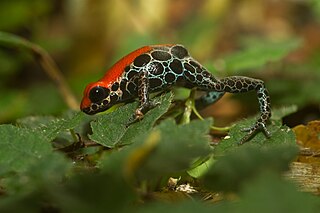
The red-backed poison frog is a species of frog in the family Dendrobatidae. It is an arboreal insectivorous species, and is the second-most poisonous species in the genus, after R. variabilis. Like many species of small, poisonous frogs native to South America, it is grouped with the poison dart frogs, and is a moderately toxic species, containing poison capable of causing serious injury to humans, and death in animals such as chickens. R. reticulata is native to the Amazon rainforest in Peru and Ecuador.

The reticulated giraffe, also known as the Somali giraffe, is a subspecies or species of giraffe native to the Horn of Africa. It lives in Somalia, southern Ethiopia, and northern Kenya. There are approximately 8,500 individuals living in the wild. The reticulated giraffe was described and given its binomial name by British zoologist William Edward de Winton in 1899, however the IUCN currently recognizes only one species of giraffe with nine subspecies.
The Nanfengmiju is a rare non-hybrid citrus.
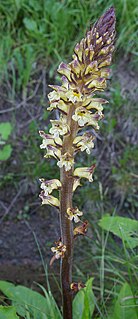
Orobanche reticulata is a species of broomrape known by the common name thistle broomrape. It is a parasitic plant whose host is normally the creeping thistle. It is native to the lowlands of Western Europe and Central Asia, but in the United Kingdom it is a rare and protected plant, growing only in Yorkshire, on grassland sites such as Quarry Moor.
Citrus ryukyuensis is a newly characterized wild citrus species native to the Ryukyus and adjacent islands, most closely related to the mainland mandarin orange, C. reticulata. As with other citrus, it is a member of the Rutaceae family. The Ryukyu and mainland species have diverged for more than 2 million years, and unlike the mainland mandarin, the Ryukyu mandarin reproduces sexually. Its hybridization with the mainland species has given rise to the unique mandarin hybrids of the islands.
















